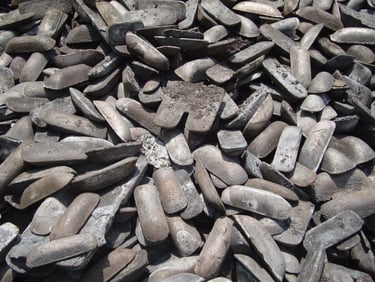Pig Iron (Crude Iron)
Pig iron is the intermediate product of ironmaking, obtained by smelting iron ore with coke and limestone in a blast furnace. It is high in carbon (3–4.5%) and often contains silicon, sulfur, phosphorus, and manganese, making it brittle and hard.
Pig iron is not used directly in construction due to its brittleness but serves as the raw material for steelmaking and cast iron production, where its composition is refined to produce stronger, more ductile iron and steel.


Pig Iron
1. Raw Materials:
Iron Ore (hematite or magnetite)
Coke (fuel and reducing agent)
Limestone (flux to remove impurities)
2. Charging the Blast Furnace:
Iron ore, coke, and limestone are layered in the blast furnace.
Hot air (sometimes enriched with oxygen) is blasted into the furnace from the bottom.
3. Reduction Reactions:
Coke burns to form CO, which reduces iron oxides to molten iron:
Fe2O3+3CO→2Fe+3CO2Fe_2O_3 + 3CO → 2Fe + 3CO_2Fe2O3+3CO→2Fe+3CO2
Limestone reacts with silica and other impurities to form slag.
4. Formation of Molten Pig Iron and Slag:
Molten pig iron collects at the bottom of the furnace.
Slag floats on top and is removed separately.
5. Tapping and Casting:
Molten pig iron is tapped from the furnace.
It is cast into pigs (rectangular molds) for transport to steelmaking units.
Summary Flow:
Iron Ore + Coke + Limestone → Blast Furnace → Molten Pig Iron + Slag → Cast into Pig Iron
© 2024 AISCO Group. All Rights Reserved.
Ore to Core
Subscribe to our newsletter


